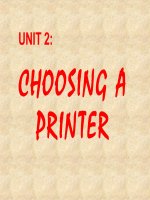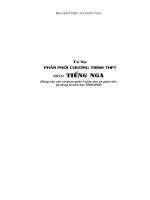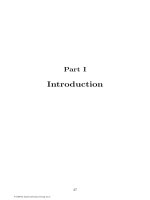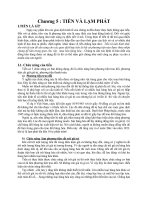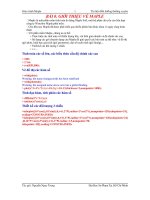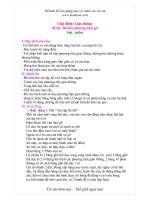Choosing pressure relief equipment DLF Factsheet pptx
Bạn đang xem bản rút gọn của tài liệu. Xem và tải ngay bản đầy đủ của tài liệu tại đây (376.12 KB, 19 trang )
© (2006) Disabled Living Foundation 1
ed.
co.uk/
Choosing pressure relief
equipment
DLF Factsheet
Sponsored by
© (2006) Disabled Living Foundation 2
© Disabled Living Foundation
All rights reserved. No reproduction or
transmission of this publication may be
made without written permission.
Inclusion (including any display
advertising) does not indicate that any
item has been recommended or tested.
All information is provided without legal
responsibility.
Disabled Living Foundation
380-384 Harrow Road London W9 2HU
Tel: (020) 7289 6111
Fax: (020) 7266 2922
Textphone: (020) 7432 8009
Helpline: 0845 130 9177 10am – 4pm
Textphone: (020) 7432 8009
Email:
Website: www.dlf.org.uk
Reg. Charity No: 290069
VAT Reg. No: 226 9253 54
© (2006) Disabled Living Foundation 3
DLF Factsheet
Contents
Choosing pressure relief equipment
INTRODUCTION 4
RISK FACTORS 7
WHO IS AT RISK? 10
REDUCING THE RISK OF PRESSURE ULCERS 8
SUPPLY AND PROVISION OF PRESSURE RELIEF EQUIPMENT 5
PROPERTIES AND FEATURES OF PRESSURE RELIEF MATTRESSES AND 11
CUSHIONS
MATERIALS USED FOR PRESSURE RELIEF EQUIPMENT
ADVICE FOR PEOPLE WHO NEED PRESSURE RELIEF WHILST SITTING IN 17
AN ARMCHAIR
TYPES OF BEDS WITH PRESSURE RELIEVING FEATURES 17
JOINT PROTECTORS 19
USEFUL ORGANISATIONS 20
© (2006) Disabled Living Foundation 4
INTRODUCTION
Pressure ulcers are areas of damage to
the skin and underlying tissue, usually
occurring over bony prominences. They
are caused by:
pressure: occurs when skin and
tissue are directly compressed
between bone and a support surface
such as a bed or wheelchair. Blood is
unable to circulate causing a
decrease of oxygen and nutrients to
the underlying cells;
shear: occurs when skin and tissue
are pulled in different directions, for
example when a person slips down a
bed or is repositioned using a
dragging motion;
* friction: occurs when the skin rubs
against a surface, for example the heels
rubbing against a sheet.
The greatest areas at risk are those
where there are weight bearing bones
near the surface of the skin, for example
under the bones in the buttocks – the
ischial tuberosities. The shoulders, hips
and heels are also at increased risk. (NB
inclusion of skeletal diagram – if not
available delete sentence referring to it)
Both people at risk and their carers need
to be aware of the importance of
pressure ulcer prevention. Pressure
ulcers can be painful, difficult to treat
and even life threatening in extreme
cases.
A prevention programme may include:
regular skin assessment; use of manual
handling aids and techniques; regular
repositioning; continence management and
the use of pressure distributing equipment.
For further information on prevention and
treatment guidelines, refer to the Royal
College of Nursing’s Pressure ulcer risk
assessment and prevention or the European
Pressure Ulcer Advisory Panel. The
Medicines and Healthcare Products
Regulatory Agency has completed
assessments regarding many types of
pressure relief equipment (see useful
contacts).
For up-to-date product and supplier
information, please contact our equipment
helpline, open Monday to Friday from
10am to 4pm, tel: 0845 130 9177 (calls
charged at local rate), or if you use
textphone: 020 7432 8009 (standard rate).
Alternatively, you can write to our letter
enquiry service or contact us via email:
. To help us give you a
concise and informative reply, please
provide us with as much detail as possible
including information on the difficulties you
are having and any solutions you have
considered, including equipment ideas.
RISK FACTORS
Several factors may increase a person’s risk
of developing pressure ulcers:
Decreased mobility
People with decreased mobility may have
difficulty relieving pressure when sitting or
© (2006) Disabled Living Foundation 5
lying. They may be unable to reposition
themselves in a chair or a bed, and may
slip down in a chair, for example,
producing a shearing effect. When
carers assist people to reposition or
transfer from a chair or bed,
inappropriate manual handling
techniques may also cause shearing or
friction.
Neurological impairment or sensory
impairment
People with neurological impairment or
decreased sensation may not feel the
uncomfortable sensation of pressure
building up and therefore not reposition
themselves to relieve pressure. These
people may not even feel when a
pressure ulcer has developed.
Incontinence
The inability to control the bladder
and/or bowel increases dampness in the
buttock and thigh area, making the skin
more prone to damage. Urine and
faeces also contain substances that can
increase the chance of skin breakdown.
Advice can be sought from a continence
nurse or from the Continence
Foundation.
Temperature and humidity
Increased heat and humidity increase
sweating which can add to the risk of
skin breakdown. Skin cell function is
also impaired if the skin becomes too
warm or too cold, increasing the skin’s
susceptibility to damage.
Decreased nutrition and circulation
People with low body fat may have
decreased subcutaneous fat and muscle
bulk, providing little padding over bony
prominences. People with high body fat
have increased padding over bony
prominences, but this tissue is poorly
vascularised and may be more prone to
shear forces. Good nutrition is also required
to repair tissue and prevent ulcer
occurrence. Good hydration is required to
maintain the resistance and elasticity of the
tissues.
WHO IS AT RISK?
In general, people who spend most of the
day lying or sitting and are unable to
reposition themselves effectively are at risk
of developing pressure ulcers.
A number of risk assessment scales are
designed to assist health professionals to
identify a person at risk of developing
pressure ulcers, including the Norton Scale
and the Waterlow Scale.
When a pressure ulcer has developed, the
ulcer is usually graded in the following way:
Grade1 – reddened skin which persists for
more than 30 minutes after pressure has
been relieved;
Grade 2 – superficial skin damage. May
present as a blister or as an abrasion;
Grade 3 – full thickness skin loss not
extending to bone or muscle. This grade of
pressure ulcer is not usually painful;
© (2006) Disabled Living Foundation 6
Grade 4 – full thickness skin loss with
extensive tissue damage through to
muscle and bone.
REDUCING THE RISK OF
PRESSURE ULCERS
Good pressure care needs to be
practised across all activities of daily
living: in the wheelchair, in bed, in the
bath and on the toilet or commode.
Correct pressure care equipment is an
important component of any prevention
programme, but should not be seen as a
complete solution.
A prevention programme for people at
risk of pressure ulcers may include the
following:
Correct positioning in bed or chair
People at risk of developing pressure
ulcers should be repositioned throughout
the day. When lying in bed, a 30 degree
tilt will minimise pressure on bony
prominences. Using a knee break and
removing any slings or slide sheets will
also protect from shear and friction.
When sitting in a chair, the chair needs
to support the full length of the user’s
thighs and keep the hips, knees and
ankles at right angles. Armrests are
required for user repositioning and
transfers.
Changing position or lifting the body
Pressure should be relieved from any
part of the body at regular internals –
especially over bony prominences. Areas at
risk include - when lying on the back:
shoulder blades, elbows, back of the head,
buttocks and heels; when lying on the side:
shoulder, ear, hips, thighs and ankles; when
sitting in a chair: buttocks, elbows and heels.
Removing pressure completely allows time
for the blood to flow normally to that area so
that skin cell oxygen levels can be restored.
If a person cannot change positions
independently he/she will need to be
repositioned or moved by a carer. It is
important to use correct manual handling
techniques when repositioning. The intervals
at which repositioning should occur depends
on the person’s level of risk. A turning chart
or clock may assist carers to establish an
effective turning regime.
Regular inspection of the skin
An initial inspection of a new patient or client
should occur immediately on admission to
hospital or when a new care team is in
place. A standardised assessment such as
the Waterlow scale should be used for this
initial assessment.
The skin should then be inspected
frequently – depending on the person’s level
of risk. Areas of risk should be inspected for:
persistent redness which does not
disappear after removal of pressure;
discoloration or a change in texture of the
skin;
warmth or swelling over a bony
prominence;
© (2006) Disabled Living Foundation 7
breaks, blisters or abrasions to the
skin.
If a person is examining him or herself, a
long handled mirror may be used.
Wearing suitable clothing and using
suitable bedding
Sitting or lying on thick clothing seams,
such as those in jeans, should be
avoided as this can contribute to
pressure ulcers.
Bedding should be free from wrinkles,
and a bed cradle may be used to
decrease the pressure of bedding
through the heels. Plastic or rubber
backed bedding may cause an increase
in moisture. Ideally, sheets and cushion
covers should be two-way stretch and
vapour permeable.
Taking care when lifting and
transferring
To reduce the effect of friction and shear
on the skin, appropriate manual handling
techniques and equipment need to be
used. Slide sheets and hoists can be
useful to reduce shear when transferring
or repositioning although they should not
be left underneath the user.
Using barrier creams
Some creams and oils may be
recommended as a preventative
measure, or to aid in healing of an
existing sore. It is important to seek
medical advice prior to use. When
washing and drying, the skin should be
treated with care, especially in at risk areas.
Talcum powder should not be used as this
can dry out the skin and may cake and
increase friction.
Using pressure relief equipment
Pressure relief equipment may include
cushions, mattresses, bed cradles and joint
protectors. Some products may have a
pressure relief rating to assist health
professionals to choose the correct pressure
relieving products for their client. These
rating have been provided by the product’s
suppliers, and are designed to provide a
guide as to the pressure relieving qualities of
that product. The ratings are intended as a
guide only, and consultation with your health
professional and the product supplier before
purchasing any equipment is strongly
advised.
SUPPLY AND PROVISION OF
PRESSURE RELIEF
EQUIPMENT
PERMANENT LOAN
Health and local authority
provision
Wheelchair cushions
The provision of wheelchair cushions is
carried out by, or through, the wheelchair
service. This is part of the health authority
and organised on a district-wide basis. Often
based at the local district hospital, such
services are able to provide a wide range of
wheelchairs and cushions. A pressure relief
cushion needs to be prescribed at the same
© (2006) Disabled Living Foundation 8
time as the wheelchair to ensure that it
does not affect the functional ability of
the user. If the cushion is too high, it
may prevent users from reaching the
propelling wheels or make it difficult for
them to get their legs under standard
height tables.
Referral
Referral to the wheelchair service can
be made by a range of professionals
including therapists, nurses and doctors.
Range of equipment available
Standard off-the-shelf cushions and
individualised made-to-measure
cushions are available. Assessment and
authorisation for these cushions needs
to be carried out by various health
professionals including an occupational
therapist and physiotherapist.
Home nursing equipment
Home nursing equipment such as
pressure relief mattresses and armchair
cushions may be supplied by a
community nurse. He/she can usually be
contacted through the local health
authority. Manual handling training and
equipment such as hoists can usually be
provided by an occupational therapist in
the community.
Referral
Referrals to community nurses and
occupational therapists can be made by a
range of health professionals including
doctors, other nurses and therapists.
Range of equipment available
A range of pressure relieving mattresses,
cushions and beds may be available as well
as manual handling equipment such as
hoists and slide sheets.
Employment service
Employment equipment and adaptations are
defined as any equipment, which is primarily
for the purpose of meeting an employment
need. This could include wheelchairs and
cushions, ramps, short rise lifts, and
stairlifts.
Employment equipment and adaptations are
provided through:
The Disability Services Teams (DSTs) part
of Job CentrePlus (previously the
Employment Service) in England, Wales and
Scotland;
Disability Employment Advisers (DEAs) who
work from local job centres and who, as well
as providing a wide range of advice and help
to people who have particular difficulties in
finding or keeping work because of a
disability, can also advise on how to obtain
equipment
© (2006) Disabled Living Foundation 9
Referral to these services is open -
either by the user, the employer, or by a
healthcare professional.
PURCHASE OF EQUIPMENT
Private purchase
Private purchase might be preferred
either because a person wishes to buy
privately, or because the statutory
services are unable to provide the item
required.
Funding from charitable
sources
A directory entitled A guide to grants for
individuals in need published by the
Directory for Social Change contains the
most complete list of the charities and
organisations that will give grants and
funding.
SELECTING APPROPRIATE
EQUIPMENT
Before you purchase a product, it may
be helpful to try it out. There are over 40
Disabled Living Centres around the
country which have a wide range of
equipment on display. All can give
advice and information on wheelchairs
and related equipment. For details of
your nearest centre, contact Disabled
Living Centres Council (see useful
addresses). Advice should always be
sought from a healthcare professional
before buying.
PROPERTIES AND
FEATURES OF PRESSURE
RELIEF MATTRESSES AND
CUSHIONS
Pressure relief products distribute pressure
in a variety of ways, including conformity
moisture absorption and reduction of shear.
Pressure relief equipment may possess the
following qualities:
CONFORMITY
Products made of water, air, gel and
memory foam move and conform to the
shape and movement of the body. However,
these products decrease the ability to relieve
pressure by leaning to one side as the
surface will move with the user.
STABILITY
The user who finds it difficult to maintain
sitting balance may find that cushions that
conform quickly to the body and move do
not feel particularly safe. They can also
make transferring on and off the surface
more difficult. If the user needs to push
down on a transfer surface to gain leverage,
the contents will move as soon as the body
weight is lifted and the support will
disappear.
BOTTOMING-OUT
If a mattress or cushion is too soft or thin, it
may become compressed, allowing the skin
to come into contact with the surface
beneath, thus removing any pressure
© (2006) Disabled Living Foundation 10
relieving qualities. This is called
bottoming out. Turning cushions and
mattresses may help to prevent this.
SHEAR FORCES
Some mattresses and cushions are
designed to reduce shear forces as
much as possible. Mattresses and
cushions which have individual balloon
or egg-box-shaped surfaces, or foam
mattresses and cushions which have a
cross cut surface are able to move with
the body so that the pull on the outer
layer of skin is decreased. Also,
cushions which are ramped and slope
backwards decrease the likelihood of
users sliding forward in the chair thereby
minimising shear.
HEAT
As heat increases so does the risk of
developing sores. Users who tend to get
hot and sweaty may prefer to use a
cushion that keeps the surface
temperature of the skin cool. Water and
gel help to conduct heat away from the
area. Gel may be too cold for some
people. Too much cold may cause the
metabolism of the cells forming the skin
cells to slow down so that they absorb
much needed oxygen more slowly.
Standard foam mattresses and cushions
and bead-filled mattresses and cushions
should be avoided by people who get
too hot, as they retain heat and do not
let air circulate. Conversely, this type of
mattress or cushion may be suitable for
people who feel the cold and need their
mattress cushion to act as insulation.
MOISTURE ABSORPTION
The amount of moisture produced may
relate to the amount of heat produced and
so may be influenced by the factors
mentioned above. Moisture absorption also
tends to be influenced by the material from
which the mattress or cushion cover is
made. Covers made of cotton and towelling
are absorbent. Vapour permeable materials,
for example platilon allow the air and water
vapour to circulate so that sweating is
minimised. However, they are also water
resistant so that, if large amounts of fluid are
spilt on it, the cushion underneath stays dry.
Natural sheepskins are able to hold a high
level of water vapour without feeling wet and
will therefore reduce the effect of sweating.
Man-made materials, such as nylon and
vinyl, are not absorbent and, because they
do not allow the air to circulate, may cause
excess sweating.
FIRE RETARDANCY
Pressure relief cushions and mattresses are
tested to criteria set by the Medical Devices
Agency (MDA). Also consider standards set
by the British Standards Institute (BSI) on
fire retardancy; these are very important,
especially for users who smoke and/or those
who are unable to get themselves out of bed
or a wheelchair in an emergency.
© (2006) Disabled Living Foundation 11
WATERPROOFING
A user with continence problems should
seek help from a continence adviser as
to how these can be managed or
prevented. Occasional accidents may be
unavoidable - So, if the mattress or
cushion is likely to be damaged if it gets
wet, adequate waterproofing should be
provided. A material such as platilon
may be used as it is both waterproof and
water permeable, i.e. moist air can
circulate through it.
CLEANING
Check whether the mattress, cushion
and/or the cover are washable and if
they can be disinfected if necessary. A
platilon cover can be wiped clean, thus
avoiding the need to launder the
contents.
MAINTENANCE
The adjustment of some mattresses and
cushions requires a certain amount of
dexterity initially so that the correct
amount of pressure relief is provided.
The means of adjustment may make it
necessary for someone other than the
user to check and make the
adjustments. Some mattresses and
cushions have power packs that could
go wrong; others may need mending
after a puncture or a split. In the case of
a wheelchair cushion, check whether the
user can carry out these checks and/or
repairs, or has a carer who could help. If
there is no one available to help, it may be
better to choose a cushion that does not
need setting up and maintaining in this way.
WEIGHT
The portability of the cushion will be
important for those users who frequently
need to lift it in and out of their wheelchair or
car. Some cushion materials, like gel or
water, are heavy and are not easy to lift
even when there are handles on the
cushion.
COST
Mattresses and cushions vary widely in
price. However, expensive ones may be
cost effective in the long run and better for
the wellbeing of the person if they prevent
sores from forming and the user from being
admitted to hospital for treatment.
TYPES OF MATERIALS USED
IN MATTRESSES, OVERLAYS
AND CUSHIONS
AIR ALTERNATING
CUSHIONS/MATTRESSES/
OVERLAYS
These are made of rows of air cells which
inflate and deflate alternately or sequentially
for a pre-set time period. This ensures that
the pressure on any given point is changing
© (2006) Disabled Living Foundation 12
continually, so that the pressure is
completely removed from that point for a
short period of time. Consequently,
pressure is then increased over the
other areas. Care must be taken to
ensure that the user can tolerate these
pressures.
The sequence of inflation and deflation
is controlled by a pump which is usually
mains powered. The interval of inflation
and deflation can also be controlled on
some models.
As with the static air cushions, they are
unlikely to provide a stable base, and
users may therefore need to consider
their method of transfer.
STATIC AIR
CUSHIONS/MATTRESSES/
OVERLAYS
The pressure relieving properties of
these cushions and overlays relies on
the fact that they are air filled.
Regular maintenance is required to
ensure the correct degree of inflation is
maintained. It is essential to check the
instructions as it is sometimes easy to
over or under inflate.
Air is channelled within these cushions
via air-filled balloons or pathways. The
balloon type increases the surface area
over which the pressure is distributed.
The pathways help the air to circulate
and to disperse the heat and moisture.
It should be remembered that air is unlikely
to form a stable base and users may
therefore need to consider their method of
transfer.
FOAM CUSHIONS/
MATTRESSES/OVERLAYS
Single or varied density
The pressure relieving qualities of foam
depend on its resilience. Foam cushions
come in a variety of thicknesses, sizes and
densities. Sometimes a cushion will be
made up of a variety of different foam
densities. The variations make allowances
for differences in the weight of a user. Foam
deteriorates if exposed to heat or ultra violet
light and should be replaced every six to
nine months. To prolong the life expectancy
and pressure relieving properties of a foam
mattress/cushion it should be turned
regularly, on a weekly basis. A high density
foam base can make the cushion last
longer. Foam cushions tend to be
lightweight and need no adjustments or
maintenance; some can be cut and sculpted
to order.
CROSS CUT/CONTOURED/
CONVOLUTED
Cross cut, contoured and convoluted foam
allows greater conformity and can reduce
friction and shear by allowing the surface to
move with the user. They also provide
greater ventilation for the skin than other
© (2006) Disabled Living Foundation 13
foams, as flat surfaced foam can act as
an insulator and increase skin
temperature.
Memory foam
Heat sensitive or conforming foam with
slow memory release models the shape
of the body better than standard foam.
The slower conforming properties of this
material may enhance stability.
GEL CUSHIONS
/MATTRESSES/OVERLAYS
Gel cushions work on the principle that
the weight of the user is distributed over
the liquid or solid gel. The gel is able to
conform to the body shape, so that the
pressure is distributed over the whole
area.
Gel is able to conduct heat away from
the user so that the cushion is cool to sit
on. Liquid gel cushions will leak when
punctured and gel cushions can be very
heavy unless they are combined with
another, lighter material.
Care needs to be taken in relation to
transfers since gel alone is unlikely to
form a stable seating base. Users may
therefore need to consider their method
of transfer.
WATERCUSHIONS/
MATTRESSES/OVERLAYS
Water cushions can be less stable than
gel (although more stable than air) and
so do not provide much postural support.
They are heavy to move and, if punctured,
the rapid loss of contents may cause a
problem. They are not stable, especially
when the user is transferring, unless the flow
of water can be reduced by enclosing it in
multiple compartments.
COMBINATION FILLING
CUSHIONS/
MATTRESSES/OVERLAYS
Cushions/mattresses/overlays that contain a
combination of pressure relieving materials
are usually arranged to provide a degree of
stability to the seating base. The
combination of different materials may have
the advantage of being lighter than one
material on its own.
These cushions must be positioned correctly
to achieve optimum pressure relief. A cover
with a positioning guide, for example “this
way up” or “this end to the back” may help.
Air and liquid
Air and liquid cushions have a compartment
for air surrounded by small water-filled cells.
When inflated, the support comes from the
air compartments. The water provides a cool
surface to sit on.
Gel cushions with a foam base
These cushions have a foam base with a gel
pad on top. The foam allows for a greater
degree of stability than gel alone. Also,
given that the amount of gel in the cushion is
small, they tend to be significantly lighter
than gel alone.
© (2006) Disabled Living Foundation 14
Water and foam
Water and foam cushions are made of
open foam filled with water. The foam
not only helps to add stability but also
helps the cushion to conform to the body
shape. They are cold to sit on and can
therefore reduce skin temperature.
However, remember that the foam will
still deteriorate so that these cushions
have quite a short life span.
Cushions with aperture
These cushions may be made of water,
gel, memory foam or any combination of
the above. They are designed to provide
relief on a commode, WC or bath hoist
seat.
ADVICE FOR PEOPLE
WHO NEED PRESSURE
RELIEF WHILST SITTING
IN AN ARMCHAIR
CHAIRS WITH INTEGRAL
PRESSURE RELIEF CUSHIONS
The integral pressure relief cushioning
on these chairs is either on the seat
base only or on the seat base and
backrest. This is an alternative to adding
pressure relief cushions to an existing
armchair. Adding extra cushions
changes the seat height and reduces the
height of the armrests or reduces the
depth of the chair. The position of the
user is not compromised in a chair with
integral pressure relief and there is less
risk that the cushion will be the incorrect
size, wrongly positioned or will slip.
USING PRESSURE RELIEF
CUSHIONS IN ARMCHAIRS
Most pressure relief cushions are designed
to work best when placed on a firm, level
wheelchair seat.
When placed on a soft chair cushion they
will lose some of their pressure relieving
properties, as a person changes position in
relation to the backrests and armrest height.
Altering the surface of the armchair may
also affect the ability of a user to get in and
out of the chair.
TYPES OF BEDS WITH
PRESSURE RELIEVING
FEATURES
LATERAL TILTING BEDS AND
DEVICES
Lateral tilting beds
These beds turn the user from side to side,
eliminating the need for turning by carers.
They provide pressure relief and assist in
postural drainage, that is, drainage of fluid
from the lungs. Turning can be programmed
or transfer facilitated.
Lateral tilting turning units
These units can be used on top of a
domestic bed. A longitudinally sectioned
mattress is alternately inflated and deflated,
© (2006) Disabled Living Foundation 15
which has the effect of tilting the person
from side to side.
The units can be controlled by the
person or the carer using a handset or
can be set to automatically turn at pre-
programmed intervals.
LOW AIR LOSS BEDS AND
MATTRESSES
These beds and mattresses have air
sacs that support the user on a cushion
of air. They work by increasing the
surface area in contact with the skin,
therefore reducing the pressure at a
particular point. Air is gradually lost and
continually replaced in response to the
weight distribution and movement of the
user.
They can be used with or without a
cover/sheet; however plastic and rubber
backed sheets should not be used as
they prevent air flow.
Some of these beds are not solid
enough for emergency resuscitation to
be effective (CPR), so they may be
supplied with emergency valves to
deflate the mattress rapidly in an
emergency.
FLUIDISATION BEDS
These beds are used mostly in hospital
or care home settings rather than in the
home. They are bath shaped. The
pressure relief they provide is the result of
pumping a large volume of air through a
mass of particles, for example silicone
beads, to make the particles behave as a
fluid. When the air pump is stopped the
beads become solid and support the user for
nursing purposes. A hoist may be needed
for transfers on/off these beds.
WATER BEDS
These beds are mostly for hospital or care
home settings rather than domestic use.
They have a fluid interior which may have a
foam perimeter helping to provide stability.
The fluid is cold to lie one; they can
therefore reduce skin temperature.
However, the fluid makes the beds very
heavy and care must be taken as to where
they are sited. Since, it is difficult to transfer
safely from a moving base, using a hoist is
recommended.
JOINT PROTECTORS
Some people need to use joint protectors for
comfort, protection and pressure relief.
These may come in the form of a pad which
is tied around the elbow or heel or in the
form of a bootee which encloses the toes.
However, ensure that the fastenings do not
exert pressure. They come in a variety of
pressure relieving materials. The following
types are available:
fleece joint protectors;
fleece bootee joint protectors;
polyester fibre joint protectors;
© (2006) Disabled Living Foundation 16
air filled or fluid filled joint
protectors;
foam joint protectors;
pads for walking equipment and
prostheses, for example to line
the socket of a prosthetic limb to
protect the skin.
USEFUL
ORGANISATIONS
British Standards Institution
BSI House
389 Chiswick High Road
London
W4 4AL
Tel: 020 8996 9001
Fax: 020 8996 7001
Email:
Website: www.bsi-global.com
Continence Foundation
307 Hatton Square
16 Baldwin Gardens
London EC1N 7RJ
Tel: 020 7404 6875
Fax: 020 7404 6875
Textphone: 020 7831 9831
Helpline: 0845 345 0165 9.30am-
13.00pm
Email:
Website: www.continence-
foundation.org.uk
ASSIST UK
Redbank House
4 St Chads Street
Cheetham
Manchester M8 8QA
Tel: 0870 770 2866
Fax: 0870 770 2867
Textphone: 0870 770 5813
Email:
Website: www.assist-uk.org
Medical and Healthcare Products
Regulatory Agency
Market Towers
I Nine Elms Lane
London
SW8 5NQ
Tel: 020 7084 3143
Fax: 020 7084 3209
Textphone:020 7084 3356
Email:
Website: www.medical-devices.gov.uk
National Bed Federation
Victoria House
Victoria Street
Taunton
Somerset
TA1 3FA
Tel: 01823 368088
Fax: 01823 350526
Website: www.bedfed.org.uk
Royal College of Nursing
20 Cavendish Square
London
W1G 0RN
© (2006) Disabled Living Foundation 17
Tel: 020 7409 3333
Fax: 020 7647 3435
Website: www.rcn.org.uk
Tissue Viability Society
Glanville Centre
Salisbury District Hospital
Salisbury
Wiltshire
SP2 8BJ
Tel: 01722 429 057
Fax:: 01722 425 263
Email:
Website: www.tvs.org.uk
European Pressure Ulcer Advisory Panel
Wound Healing Institute
Dept of Dermatology
Churchill Hospital
Old Road
Headington
Oxford
OX3 7LJ
Tel: 01865 228264
Fax: 01865 228233
Email:
europeanpressureulceradvisepanel@compu
serve.com
© (2006) Disabled Living Foundation 18
DLF online
The majority of DLF’s advice is now online. If you would like advice and support to get online
or information on local courses about getting online please visit one of the following websites.
Age UK
Call 0800 169 8787
BBC Webwise
Call 08000 150 950
Digital Unite
Call 0800 228 9272 Or you can write to them
Digital Unite Limited, Unit 2B Poles Copse, Poles Lane, Otterbourne, Winchester, SO21 2DZ
Go On
Call 0800 77 1234
UK online centres, The Quadrant, 99 Parkway Avenue, Parkway Business Park, Sheffield, S9 4WG
UK Online Centre
© (2006) Disabled Living Foundation 19
